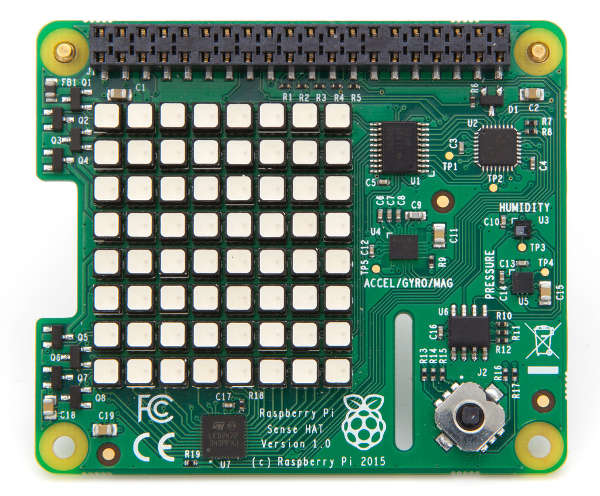| Now You Can Buy The Raspberry Pi HAT That Went Into Space |
| Written by Harry Fairhead | |||
| Wednesday, 26 August 2015 | |||
|
OK it hasn't actually got to space just yet but it is on its way. When the Sense HAT was announced everyone seemed envious that this multifunction add-on board was available to space men but not to us IoT men. Now it is and for just $30. The Raspberry Pi has certainly shaken up all ideas of what hardware you can get for a few tens of dollars. However, my guess is that many Pi-ers were prepared to pay more for one of the Sense HATs that was designed for the Astro Pi mission. In case you missed our earlier report, this is a project that will see two Raspberry Pis, two Sense HATs and a lot of code written by UK school kids hosted on the International Space Station.
The spec of the Sense HAT is good enough for many a terrestrial mission let alone space: Sensing elements: Pressure / Temperature
Humidity / Temperature
Acceleration/Gyroscope/Magnetic field
Each of these measurement channels has 16 bits of resolution. As the announcement of the availability of the Sense HAT puts it: All of these sensors have features for periodic sampling of sensor values – complete with internal FIFO storage. The LPS25H and HTS221 have maximum sample rates of 25 per second, the LSM9DS1 has a maximum sample rate of 952Hz – we are already imagining the birth of a million Pi-controlled stunt quadcopters. In addition to the sensors there is also a “D-pad” style 5-button joystick and an 8x8 LED display with 15 bit RGB color!
The sensors are looked after by an Atmel AVR microcontroller – an ATTiny88. This communicates with the Pi via an I2C bus, but don't worry the software takes care of all of the details. More interestingly the ATTiny88 also connects via an SPI interface, which means you can program it via the Pi i.e. while it is in use. This is one of the advantages of the HAT design and it means that you can develop custom firmware for the device. If you just want to use the HAT then plug it in, install some software and start programming. The LED matrix appears as a Linux framebuffer device and the joypad appears as a standard input device so you can use both from the command line or in any programming language you care to use.
The Sense HAT is available now at a cost of around $30, not including some small parts and taxes. At this cost it makes sense to stop building separate sensors for the Pi and buy a Sense HAT even if you don't need all of the sensors. The design is open source and you can see the schematics on the Raspberry Pi website and the code on GitHub. More InformationSense HAT - Make your own Astro-Pi! Related ArticlesAstro Pi - What Can A Raspberry Pi Do In Space? Windows 10 IoT Core - Raspberry Pi Home Automation Contest Raspberry Pi 2 Is Top Single Board Computer Five Million - That's A Lot Of Raspberry Pi Raspberry Pi 2 - Quad Core And Runs Windows Exploring Edison - Meet Edison
To be informed about new articles on I Programmer, install the I Programmer Toolbar, subscribe to the RSS feed, follow us on, Twitter, Facebook, Google+ or Linkedin, or sign up for our weekly newsletter.
Comments
or email your comment to: comments@i-programmer.info |
|||
| Last Updated ( Wednesday, 26 August 2015 ) |



